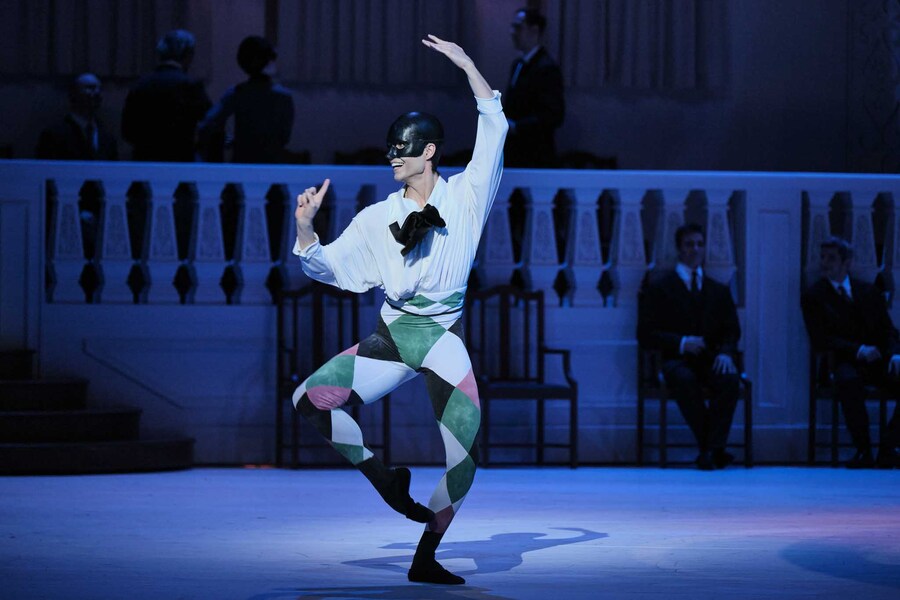The Semperoper Ballett company performs John Neumeier's full-length homage to dance legend Vaslav Nijinsky.
Choreography, set and costumes: John Neumeier
Music by Frédéric Chopin, Nikolai Rimsky-Korsakov, Dmitri Shostakovich and Robert Schumann
Premiere
24. January 2025
Dates & Cast
- Conductor Simon Hewett
- Choreography John Neumeier
- Licht, Bühne und Kostüme unter teilweiser Verwendung der Originalentwürfe von Léon Bakst und Alexandre Benois John Neumeier
- Music Frédéric Chopin, Nikolaj Rimskij-Korsakow, Dmitri Schostakowitsch, Robert Schumann
- Staged by Piotr Stanczyk, Sonja Tinnes, Leslie McBeth, Ivan Urban
- Conductor Simon Hewett
- Choreography John Neumeier
- Licht, Bühne und Kostüme unter teilweiser Verwendung der Originalentwürfe von Léon Bakst und Alexandre Benois John Neumeier
- Music Frédéric Chopin, Nikolaj Rimskij-Korsakow, Dmitri Schostakowitsch, Robert Schumann
- Staged by Piotr Stanczyk, Sonja Tinnes, Leslie McBeth, Ivan Urban
- Conductor Simon Hewett
- Choreography John Neumeier
- Licht, Bühne und Kostüme unter teilweiser Verwendung der Originalentwürfe von Léon Bakst und Alexandre Benois John Neumeier
- Music Frédéric Chopin, Nikolaj Rimskij-Korsakow, Dmitri Schostakowitsch, Robert Schumann
- Staged by Piotr Stanczyk, Sonja Tinnes, Leslie McBeth, Ivan Urban
- Conductor Simon Hewett
- Choreography John Neumeier
- Licht, Bühne und Kostüme unter teilweiser Verwendung der Originalentwürfe von Léon Bakst und Alexandre Benois John Neumeier
- Music Frédéric Chopin, Nikolaj Rimskij-Korsakow, Dmitri Schostakowitsch, Robert Schumann
- Staged by Piotr Stanczyk, Sonja Tinnes, Leslie McBeth, Ivan Urban
- Conductor Simon Hewett
- Choreography John Neumeier
- Licht, Bühne und Kostüme unter teilweiser Verwendung der Originalentwürfe von Léon Bakst und Alexandre Benois John Neumeier
- Music Frédéric Chopin, Nikolaj Rimskij-Korsakow, Dmitri Schostakowitsch, Robert Schumann
- Staged by Piotr Stanczyk, Sonja Tinnes, Leslie McBeth, Ivan Urban
- Conductor Simon Hewett
- Choreography John Neumeier
- Licht, Bühne und Kostüme unter teilweiser Verwendung der Originalentwürfe von Léon Bakst und Alexandre Benois John Neumeier
- Music Frédéric Chopin, Nikolaj Rimskij-Korsakow, Dmitri Schostakowitsch, Robert Schumann
- Staged by Piotr Stanczyk, Sonja Tinnes, Leslie McBeth, Ivan Urban
- Conductor Simon Hewett
- Choreography John Neumeier
- Licht, Bühne und Kostüme unter teilweiser Verwendung der Originalentwürfe von Léon Bakst und Alexandre Benois John Neumeier
- Music Frédéric Chopin, Nikolaj Rimskij-Korsakow, Dmitri Schostakowitsch, Robert Schumann
- Staged by Piotr Stanczyk, Sonja Tinnes, Leslie McBeth, Ivan Urban
In brief
What better way to celebrate the 200th birthday of the Semperoper Ballett than with a tribute to the genius of Vaslav Nijinsky? His name and that of the Ballets Russes are closely associated with the history of dance in Dresden.
As biographer Richard Buckle once put it: „Nijinsky’s life can be simply summarized: ten years of growing; ten years of learning; ten years of dancing; thirty years in eclipse.” The work and life of this unparalleled performer has proved an inexhaustible theme for John Neumeier since his youth. The ballet he created in 2000 about the luminous dancer deals with the biography of a soul, interwoven with memories and associations, feelings and states. Neumeier’s choreographic explorations aim to create something living out of the past, with newly defined power relations and fields of tension that capture Nijinsky’s on-stage magic as well as the dangers he encountered outside the theatre.
Storyline
On January 19, 1919 at five o’clock in the afternoon in a ballroom of the Suvretta House Hotel in St. Moritz, Switzerland, Vaslaw Nijinsky danced publicly for the last time. He called this performance his “Wedding with God”. My ballet Nijinsky begins with a realistic recreation of this situation. The choreography which follows, however, visualizes his thoughts, memories and hallucinations during this last performance.
Part I
Prompted by the imagined appearance of his former mentor, impresario and lover, Serge Diaghilev, Nijinsky recalls images of his sensational career with the Ballets Russes. Dancers, as aspects of his personality ant artistry, perform fragments from his most famous roles. Harlequin, the Poet from Les Sylphides, the Golden Slave from Sheherazade and the Spirit of the Rose merge and mingle with characters from his private life.
His sister Bronislava, later a choreographer, his older brother Stanislav, trained also to be a dancer – but marked from childhood by signs of madness – and his mother, the dancer Eleonora Bereda, who along with his father Thomas were the children’s first teachers, also appear in his dreamlike fantasy.
In another scene of the ballet, Nijinsky remembers his search for a new choreographic language. His experiments with movement result in his own original ballets: L’Après-midi d’un faune, Jeux, Le Sacre du printemps, and later Till Eulenspiegel.
A woman in red, Romola de Pulszky, who will later become Nijinsky’s wife, criss-crosses his confused recollections. He relives their first encounter on a ship to South America and their abrupt marriage – an event that causes the ultimate break with Diaghilev and the Ballets Russes.
Part II
Nijinsky’s madness drives him more and more inside himself. Memories of childhood, family, school, and the Mariinsky Theatre blend with nightmare visions of World War I – and his wife’s infidelity.
The scandalous premiere of his ballet Le Sacre du printemps appears juxtaposed with the brutality of World War I and his brother Stanislav’s death. Romola is with him through difficult and bad times.
In Nijinsky’s eyes, it is the world around him, not “Nijinsky”, that has gone mad … The Suvretta House performance and my ballet end with Nijinsky’s last dance – the War.
John Neumeier, Hamburg 2000

















